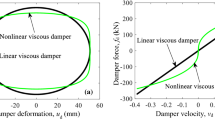Abstract
Viscous fluid dampers have been used in many building and bridge construction projects for earthquake damage mitigation. Previous study has shown that silicone oil properties, such as the fluid shear-thinning and relaxation effects, play important roles for the annular-orificed fluid damper behavior, and the Navier-Stokes equations based on these mechanisms were developed. In the current study, attempts are made to explain the effects of frequency, damper dimensions, and viscosity of silicone oil on the damper stiffness behavior using the developed equations. It is found that the developed equations successfully explain the observed phenomena. To avoid the complicated fluid dynamics analyses for damper parameters, such as the damping factor and the velocity power exponent, a new four-parameter equation considering both the fluid shear-thinning and stiffness effects, with a form similar to the widely used two- or three-parameter equation is proposed. The results of the new model successfully capture the damper behavior both at low and high frequencies and show an advantage that better consistent results can be obtained in the velocity range for the building and bridge applications.
Similar content being viewed by others
References
Constantinou, M.C., Symans, M.D.: Experimental investigation of seismic response of structures with supplemental fluid viscous dampers. Res Rep NCEER-92-0032, State University of New York at Buffalo (1992)
Tsopelas, P., Okamoto, S., Constantinou, M.C., Ozaki, D., Fujii, S.: Experimental and analytical study of systems consisting of sliding bearings, rubber restoring force devices, and fluid dampers. Res Rep NCEER-94-0002, State University of New York at Buffalo (1994)
Reinhorn, A.M., Li, C., Constantinou, M.C.: Experimental and analytical investigation of seismic retrofit of structures with supplemental damping, part 1-fluid viscous damping devices. Res Rep NCEER-95-0001, State University of New York at Buffalo (1995)
Taylor, D.P.: Fluid dampers for applications of seismic energy dissipation and seismic isolation. In: Proceedings of the 11th World Conference on Earthquake Engineering paper No. 798, Acapulco (1996)
Seleemah, A.A., Constantinou, M.C.: Investigation of seismic response of buildings with linear and nonlinear fluid viscous dampers. Res Rep NCEER-97-0004, State University of New York at Buffalo (1997)
He L., Zheng G.T.: Effect of viscous heating in fluid damper on the vibration isolation performance. Mech. Syst. Signal Process. 21, 3060–3071 (2007)
Mcnamara R.J., Taylor D.P.: Fluid viscous dampers for high-rise buildings. Struct. Des. Tall Spec. Bldg. 12, 145–154 (2003)
Ribakov Y., Dancygier A.N.: High-efficiency amplifiers for viscous damped structures subjected to strong earthquakes. Struct. Des. Tall Spec. Bldg. 15, 221–232 (2006)
Di Paola M., Mendola L.L., Navarra G.: Stochastic seismic analysis of structures with nonlinear viscous dampers. J. Struct. Eng. 133, 1475–1478 (2007)
Markis N., Burton S., Hill D., Jordan M.: Analysis and design of ER damper for seismic protection of structures. J. Eng. Mech. 122, 1003–1011 (1996)
Chen, H.-Y.: Physical properties of fluid dampers. Dissertation, National Cheng Kung University (in Chinese) (2001)
Hou C.-Y.: Fluid dynamics and behavior of nonlinear viscous fluid dampers. J. Struct. Eng. 134, 56–63 (2008)
Currie C.C., Smith B.F.: Flow characteristics of organopolysiloxane fluids and greases. Ind. Eng. Chem. 42, 2457–2462 (1950)
Lee C.L., Polmanteer K.E., King E.G.: Flow behavior of narrow-distribution polydimethylsiloxane. J. Polym. Sci. Part A 28, 1909–1916 (1970)
Cross M.M.: Rheology of non-newtonian fluids: a new flow equation for pseudoplastic systems. J. Colloid Sci. 20, 417–437 (1965)
Raju K.V.S.N., Krishna D., Ramma D.G., Reddy P.J., Yaseen M.: Assessment of applicability of carreau, ellis, and cross models to the viscosity data of resin solutions. J. Appl. Polym. Sci. 48, 2101–2112 (1993)
Yasuda, K.: Investigation of the Analogies Between Viscometric and Linear Viscoelastic Properties of Polystyrene Fluids. Dissertation, MIT (1979)
Carreau P.J.: Rheological equations from molecular network theories. Trans. Soc. Rheol. 16, 99–128 (1972)
Hou C.-Y., Hsu D.-S., Lee Y.-F., Chen H.-Y., Lee J.-D.: Shear-thinning effects in annular-orifice viscous fluid dampers. J. Chin. Inst. Eng. 30, 275–287 (2007)
Ferry J.D.: Viscoelastic Properties of Polymers. Wiley, New York (1980)
Author information
Authors and Affiliations
Corresponding author
Rights and permissions
About this article
Cite this article
Hou, CY. Behavior explanation and a new model for nonlinear viscous fluid dampers with a simple annular orifice. Arch Appl Mech 82, 1–12 (2012). https://doi.org/10.1007/s00419-011-0534-z
Received:
Accepted:
Published:
Issue Date:
DOI: https://doi.org/10.1007/s00419-011-0534-z




